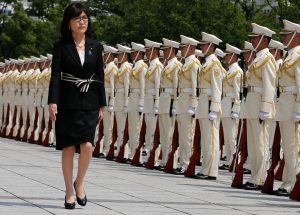In his first official trip as secretary of defense, Jim Mattis traveled to East Asia, with scheduled stops in South Korea and Japan.
“It is a priority for President Trump’s administration to pay attention to the northwest Pacific,” Mattis told the New York Times. “I am going to get current by listening to them, finding out where their issues are, and then we are going to work together and strengthen our alliance.”

Mattis arrived in South Korea on February 1 and met with South Korean Minister of National Defense Han Min-koo (at left). He is scheduled to visit Japanese Defense Minister Tomomi Inada (below) on February 3.
The four-day trip aims to “underscore the commitment of the United States to our enduring alliances with Japan and the Republic of Korea and further strengthen U.S.-Japan-Republic of Korea security cooperation,” the Pentagon said before the trip.

Mattis previously commanded U.S. Central Command, which covers the Arabian Gulf region into Central Asia, and spent more than four decades in uniform at all levels of the Marine Corps.
Long history with both countries
Since the end of World War II, the U.S. has maintained strong economic and strategic relationships with both governments and has played an important role in supporting them.
Today, Japan and South Korea are the fourth- and sixth-largest trading partners of the U.S. The U.S., meanwhile, is the second-largest trading partner for both countries.
Security has always been a pillar of the relationships between the U.S. and both countries. The U.S. has 27,500 troops in South Korea and roughly 54,000 service members in Japan, which hosts several military bases and does not have an offensive military.









![Immigrants find success in Silicon Valley’s venture capital industry [video] Two people in front of freshdesk logo (VOA)](https://webarchive.library.unt.edu/web/20170207001655im_/https://share.america.gov/wp-content/uploads/2017/01/maxresdefault-2-218x150.jpg)















